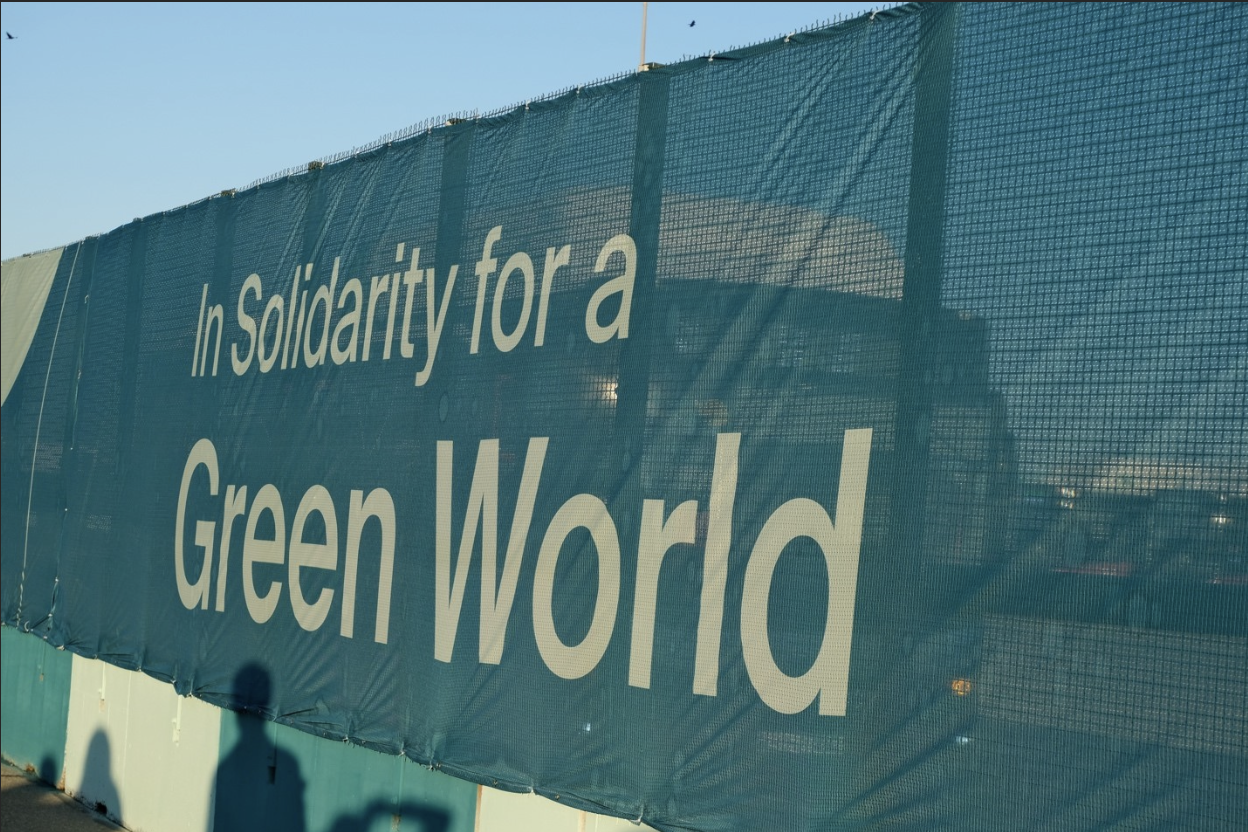By Megan O’Brien, ’25, Environmental Studies
If I had to simplify my first day at COP down to one word it would be: whirlwind. I truly was running around all day trying to take in as much as I could. Going forward, I will be approaching this COP with a quality-over-quantity mindset. For my first blog post I wanted to share my initial impressions and the things that I found especially relevant. To start off I want to talk a bit about the venue. COP29 is being held in Baku Arena, a large venue whose exterior is made up of illuminated screens that, once the sun sets, display different messaging. Energy efficient right? Not. The inside of the venue is head-to-toe “sea-breeze” green (both a light and dark shade). Messaging on the walls includes “In Solidarity for a Green World,” “Mobilizing funds and enabling action to keep 1.5 degrees Celsius within reach,” and much more. Each is vaguely suggestive of climate action and left me feeling slightly greenwashed. Driving out of the city on our first day I was overwhelmed by the presence of oil and gas all along the coast. I knew going in that Azerbaijan was known as a “petro-state” but seeing it was different. Within this context, each of these previous statements feel insufficient or lacking. I can’t help thinking that a more powerful statement would be “we have cut our oil and gas emissions by some percentage,” or something else actionable. Now don’t get me wrong, walking into the venue I was struck by the pristine space and how color coordinated the layout and general designs are. Everything is pristine and color coordinated. Aesthetically, COP29 meets all sorts of design goals. When one enters the venue the first thing one sees are the side event rooms, which were convenient as we started off the day in a RINGO, Research and Independent Non-Governmental Organization, debrief just beyond the entrance. If you carry on straight into the venue, you will enter a very lengthy hallway that has a right turn off to the service hub (water bottle pick up location) and left turn off to the pavilions. You can also find the food court further down to the left. Eventually you will come to the larger press conference rooms where the opening plenaries were held today.

Something that came up in nearly every meeting I attended today was the idea of local action and sub-national governance. Perhaps in part in response to the US election, there was a strong focus on what local governments can do to combat climate change around the globe. Interestingly, this seems to undermine the work being done at the UN level, we are here for international agreements after all. In theory, if everyone held up their end of the deal as it is laid out in the Paris Agreement, this emphasis would not be needed. I am curious to follow how emphasis on local efforts either supports or serves as an alternative to global efforts that may be falling short. Many meetings today mentioned the findings from last year’s Global Stocktake, where it was identified that we are not on track to stay below 1.5 degrees Celsius of warming. One meeting organized by the UN Global Innovation Hub reframed the 1.5 goal as “a planetary boundary” where devastating loss will occur if that amount of warming is reached. In a later meeting with US delegates regarding climate lingo, Wren Elhai shared that many people, when asked, assume that 4 degrees of warming would be a devastating amount. His point was that many members of civil society do not possess adequate understanding of climate science to understand the implications of 1.5 by 2030.

Eating was quite an experience as well. Note to any future COP goers: don’t wait until 2:30 to eat after being on your feet all day and bring more snacks than you think you’ll need! The food court has a variety of different options and an overflowing recycling bin full of paper covered in food. The irony of this image has stuck with me. For people from around the world gathering to address the climate crisis, appropriately recycling would seem to me to be the bare minimum, however day 1 of COP29 had overflowing bins that could hardly close and were incorrectly sorted. While exploring COP, two questions kept coming to mind: how is this all being powered and what does the waste from this conference look like? Since making art is a sidelong endeavor for me during this process, I was imagining what an art project regarding waste at COP would look like. It’s something to think about while moving forward at COP.
My final thoughts to conclude these first impressions are about Azerbaijan as the host country for COP29. Tomorrow, I will be lucky to attend a discussion between the US, China, and Azerbaijan regarding methane and non-CO2 greenhouse gas emissions. The context of Azerbaijan as an autocratic “petro-state” cannot be forgotten. I am curious to see how this shows up at COP either in the form of protest or just in discussion. Now that I feel like I have gotten a better lay of the land, I am anxious to get back into the Blue Zone and learn even more.

did you see all the private jets that arrived? and everybody driving around in limo’s. What bus?